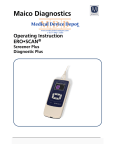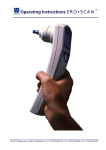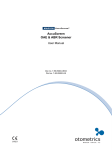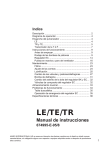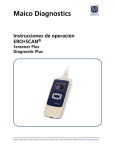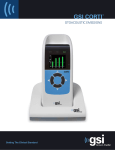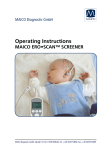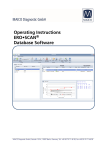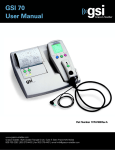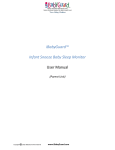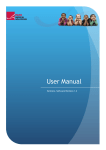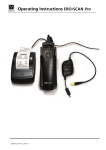Download ERO•SCAN® Operating Instruction
Transcript
Maico Diagnostics Operating Instruction ERO•SCAN® MAICO Diagnostic •7625 Golden Triangle Drive • Eden Prairie, MN • 55344 • Tel: 888-941-4201 • Fax: 952-903-4100 ERO•SCAN® Operating Instruction Table of Contents 1 Standards Compliance ............................................................................. 1 2 Warranty .................................................................................................. 2 2.1 3 Intended Use ........................................................................................................................................3 Warnings, Cautions, and Errors .............................................................. 4 3.1 Status/Error Messages .........................................................................................................................5 4 Customer Responsibility .......................................................................... 6 5 Safety Precautions ................................................................................... 7 5.1 Cautions - General................................................................................................................................7 5.2 Warning - Electric Shock Hazards.........................................................................................................8 5.3 Warning - In Case of Emergency ..........................................................................................................8 5.4 Warning - Explosion .............................................................................................................................8 5.5 Warning - Battery Safety ......................................................................................................................8 5.6 Warning - General ................................................................................................................................8 6 Recycling/Disposal ................................................................................... 9 7 Regulatory Symbols............................................................................... 10 8 Introduction ........................................................................................... 12 9 8.1 How Does the ERO•SCAN® Device Work?......................................................................................... 12 8.2 How are the Results Stored and Reported? ..................................................................................... 13 8.3 Sensitivity and Specificity .................................................................................................................. 13 Setup ...................................................................................................... 14 9.1 Unpacking the System....................................................................................................................... 14 9.2 Battery Charging ............................................................................................................................... 14 9.3 Installing the Micro-Probe ................................................................................................................ 15 9.4 Attaching Eartips ............................................................................................................................... 16 10 Operating Instructions .......................................................................... 17 10.1 Preparing the Patient for Testing ...................................................................................................... 17 10.2 Turning On the Instrument ............................................................................................................... 17 i 8105730 Rev B ERO•SCAN® Operating Instruction 10.3 Control Panel..................................................................................................................................... 18 10.4 Main Menu........................................................................................................................................ 18 10.5 Selecting the Test Protocol ............................................................................................................... 19 10.6 AutoStart (Beginning a Test) ............................................................................................................. 19 10.7 Calibration and Test .......................................................................................................................... 20 10.8 Viewing Results ................................................................................................................................. 21 10.9 Test Technique .................................................................................................................................. 22 10.10 Noise Sources ................................................................................................................................ 22 10.11 Turning Off the Instrument ........................................................................................................... 22 11 Managing Results .................................................................................. 23 11.1 Saving Results.................................................................................................................................... 23 11.2 Printing to a Thermal Printer ............................................................................................................ 23 11.3 Connecting to the PC Database Software ......................................................................................... 24 12 MPT-II SANIBEL Mobile thermal mini printer ....................................... 25 12.1 Operation .......................................................................................................................................... 26 13 Interpreting Results ............................................................................... 29 13.1 Understanding the Display................................................................................................................ 29 13.2 Understanding the DPOAE Printout.................................................................................................. 30 13.3 Understanding the TEOAE Printout .................................................................................................. 30 14 Rounding Results ................................................................................... 31 15 Clock Settings ........................................................................................ 32 15.1 Accessing the clock menu ................................................................................................................. 32 15.2 Changing the Date/Time ................................................................................................................... 32 16 Instrument Settings ............................................................................... 33 16.1 Bluetooth® Device Pairing ................................................................................................................. 33 16.2 Clearing Test Results ......................................................................................................................... 34 16.3 Auto Shutdown Time ........................................................................................................................ 34 16.4 Save Mode/Storing Test Results ....................................................................................................... 34 16.5 Minimum Amplitude ......................................................................................................................... 35 16.6 Clock Mode ....................................................................................................................................... 35 ii 8105730 Rev B ERO•SCAN® Operating Instruction 16.7 Language ........................................................................................................................................... 35 16.8 Reset to Default ................................................................................................................................ 36 17 Advanced Options for DPOAE Testing ................................................. 37 17.1 Instructions for Customizing a Test Protocol .................................................................................... 37 17.2 Selecting the Level of Primary Tones ................................................................................................ 38 17.3 Setting the Averaging Time ............................................................................................................... 38 17.4 Setting the PASS SNR Level ............................................................................................................... 38 17.5 Setting the Number of Frequencies for PASS ................................................................................... 39 17.6 Reset Protocol ................................................................................................................................... 39 17.7 Save Protocol .................................................................................................................................... 39 18 Advanced Options for TEOAE Testing .................................................. 40 18.1 Instructions for Customizing a Test Protocol .................................................................................... 40 18.2 Selecting the Averaging Time............................................................................................................ 41 18.3 Setting the PASS SNR Level ............................................................................................................... 41 18.4 Setting the Number of Frequencies for PASS ................................................................................... 41 18.5 Reset Protocol ................................................................................................................................... 42 18.6 Save Protocol .................................................................................................................................... 42 19 Cleaning and Maintenance ................................................................... 43 19.1 Cleaning and Disinfection ................................................................................................................. 43 19.2 Maintenance ..................................................................................................................................... 44 19.3 Probe Tube Replacement.................................................................................................................. 44 20 Troubleshooting .................................................................................... 45 21 Specifications ......................................................................................... 48 Appendix A: Flowcharts .............................................................................. 50 Appendix B: Test Sequence ........................................................................ 52 Appendix C: Pass/Refer Criteria .................................................................. 54 Appendix D: Configurations and Test Protocols........................................ 57 Appendix E: EMC Compatibility ................................................................. 58 iii 8105730 Rev B ERO•SCAN® Operating Instruction Title: ERO•SCAN® OAE Instrument – Operating Instructions MAICO Diagnostic 7625 Golden Triangle Drive Eden Prairie, MN 55344 Tel.: 888.941.4201 Fax: 952.278.4481 E-mail: [email protected] Internet: www.maico-diagnostics.com EC REP MAICO Diagnostic GmbH Salzufer 13/14 10587 Berlin Germany Tel.: +49 30 – 70 71 46 50 Fax: +49 30 – 70 71 46 99 E-mail: [email protected] Internet: www.maico.biz Copyright © 2014 MAICO Diagnostic. All rights reserved. No part of this publication may be reproduced or transmitted in any form or by any means without the prior written permission of MAICO. The information in this publication is proprietary to MAICO. Compliance MAICO Diagnostic is an ISO 13485 certified corporation. iv 8105730 Rev B ERO•SCAN® Operating Instruction 1 Standards Compliance Standard Issue Date Title ANSI/ASA 3.6 2010 Specification for Audiometers IEC 60601-1 2007 IEC 60645-1 2004 Medical Electrical Equipment – General Requirements for Basic Safety and Essential Performance, Ed. 3 Electroacoustics – Audiological equipment – Part 1: Puretone audiometers IEC 60645-3 2007 Electroacoustics – Audiometric equipment – Part 3: Test signals of short duration IEC 60645-6 2010 Electroacoustics – Audiometric Equipment – Part 6: Instruments for the measurement of otoacoustic emissions ISO 14971 2007 Application of Risk Management to Medical Devices ISO 10993 2009 Biological Evaluation of Medical Devices EN 60601-1-2 2007 Medical electrical equipment – Part 1-2: General requirements for basic safety and essential performance – Collateral standard: Electromagnetic compatibility – Requirements and Tests FCC 47CFR, Part 15.247 & 15.249 (Bluetooth®) FCC Part 15 UL 60601-1 2005 Clause 8.9.1.8; Pollution Degree Classification: 2 1 8105730 Rev B ERO•SCAN® Operating Instruction 2 Warranty MAICO Diagnostic warrants that this product is free from defects in material and workmanship and, when properly used, will perform in accordance with applicable specifications. If this instrument does not meet these criteria within one year of original shipment, it will be repaired, or at our option, replaced at no charge when returned to our service facility. NOTE: Changes in the product not approved by MAICO Diagnostic shall void this warranty. MAICO Diagnostic shall not be liable for any indirect, special or consequential damages, even if notice has been given of the possibility of such damages. THIS WARRANTY IS IN LIEU OF ALL OTHER WARRANTIES, EXPRESSED OR IMPLIED, INCLUDING, BUT NOT LIMITED TO, ANY IMPLIED WARRANTY OF MERCHANTABILITY OR FITNESS FOR A PARTICULAR PURPOSE. For assistance with this ERO•SCAN® Otoacoustic Emission Test System contact your Special Equipment Distributor or contact MAICO Diagnostic by phone at 888.941.4201 or by fax at 952.903.4100. 2 8105730 Rev B ERO•SCAN® Operating Instruction 2.1 Intended Use The ERO•SCAN® OAE Test Instrument is indicated for testing of cochlear function in infants, children, and adults by measuring otoacoustic emissions (OAEs). This instrument is suitable for use in all settings, including hospitals, schools, physician's offices, and audiologist practices. Factory defined protocols allow for simple screening measurements and user customizable protocols allow for diagnostic evaluations. The ERO•SCAN® is intended to be used by hearing healthcare professionals (i.e. ENT doctors, audiologists) and/or technicians, neonatal nurses and school nurses who have been trained by a hearing healthcare professional. In this manual the following two labels identify potentially dangerous or destructive conditions and procedures. WARNING The WARNING label identifies conditions or practices that may present danger to the patient and/or user. CAUTION The CAUTION label identifies conditions or practices that could result in damage to the equipment NOTE: Notes help you identify areas of possible confusion and avoid potential problems during system operation. 3 8105730 Rev B ERO•SCAN® Operating Instruction 3 Warnings, Cautions, and Errors WARNING The ERO•SCAN® Otoacoustic Emission Test System should be charged using only the provided power supply. Injury to personnel or damage to equipment can result when a three-prong to twoprong adaptor is connected between the ERO•SCAN® power supply and an AC outlet. No modifications of the equipment are allowed by anyone other than a qualified MAICO representative. Modification of the equipment could be hazardous. The ERO•SCAN® product has been verified by an independent laboratory to conform to international standards for EMC (electromagnetic emissions and immunity). The user is advised to avoid installation and use of this instrument in proximity with other devices or equipment that may emit or be susceptible to electromagnetic interference, including mobile phones. If the instrument is used adjacent to other devices or equipment, the user is instructed to verify that no disturbance is found in the operation of this or other equipment in proximity. Instruments which bear the Underwriters Laboratories, Inc. label should be interconnected with accessories that have the proper electrical compatibility and are listed as meeting the requirements of the UL Medical and Dental Equipment Standard. Connection of accessories not meeting these requirements may result in electrical leakage currents in excess of those allowed by the standard and present a potential electrical shock hazard to the person being tested. This icon indicates that patient applied parts of the instrument conform to IEC 60601-1:2005, Type B requirements. Any program aimed at obtaining reliable measurements of otoacoustic emissions should be staffed and supervised by appropriately-trained individuals. 4 8105730 Rev B ERO•SCAN® Operating Instruction 3.1 Status/Error Messages Display Messages: Attach Probe BT Device Not Found BT Error #xxx BT Not Configured Device not Responding Due For Service Fit Error Cannot Obtain L Fit Error Too High Fit Error Too Low Limit Error Memory Almost Full Memory Full! Power Low! Printer Error Printer Paper Out! Time/Date Error No probe is detected at the start of a test. The paired Bluetooth® device cannot be detected. The device may be turned off or too far away. There is an error condition with the Bluetooth® device. Check the status. The ERO•SCAN® instrument is not paired with any Bluetooth® device. The printer is not responding to queries from the instrument. Indicates calibration of instrument is recommended. Message will appear upon the calibration due date set in the device. Message appears during device startup once per day. For a DP test, the desired level (L1 or L2) cannot be obtained within allowable limits. User should refit the probe and retry the test. For a DP test, the level of the calibration tone is too high. User should refit the probe and retry the test. For a DP test, the level of the calibration tone is too low. User should refit the probe and retry the test. Overflow error during the calculation of the DFTs for a DP test. User should repeat the test. Saved tests are within 5 tests of the maximum limit. The maximum saved test limit is reached. The user will need to clear the memory before any additional tests can be performed. The battery charge level is too low for operation. The user must charge the battery before additional tests can be performed. Indicates a problem with the printer. Check the printer status. Indicates that printer paper has run out. The clock is checked during power on to ensure it has not lost time and been reset. In the case of clock reset, this message is shown. The user should set the correct date/time. Indicator LEDs (lights): The indicator labeled ‘NOISE’ provides a visual indication (AMBER) that the NOISE / Orange TEST / Yellow READY / Green CHARGE / Blue noise level measured during the test exceeds a nominal threshold. Also used to indicate some error conditions and when the outcome of test is REFER, NOISY, or NO SEAL. The indicator labeled ‘TEST’ provides a visual indication (YELLOW) that the selected test is being performed. This indicator will remain on steady state during the test function. The indicator labeled ‘READY’ lets the user know that the instrument is not currently performing a test function and that it is available to perform a test function. The indicator labeled ‘CHARGE’ provides a visual indication (BLUE) of the battery recharging function and battery status. The rate of illumination of the indicator provides a means of identifying the status of the charging function. 5 8105730 Rev B ERO•SCAN® Operating Instruction 4 Customer Responsibility WARNING This product and its components will perform reliably only when operated and maintained in accordance with the instructions contained in this manual, accompanying labels, and/or inserts. A defective product should not be used. Make sure all connections to external accessories are snug and secured properly. Parts which may be broken or missing or are visibly worn, distorted, or contaminated should be replaced immediately with clean, genuine replacement parts manufactured by or available from MAICO. This product should not be used in the presence of fluid that can come into contact with any of the electronic components or wiring. Should the user suspect fluids have contacted the system components or accessories, the unit should not be used until deemed safe by a MAICO certified service technician. Do NOT use in the presence of flammable gaseous mixtures. Users should consider the possibility of explosions or fire when using this device in close proximity to flammable anesthetic gases. Do NOT use the ERO•SCAN® in a highly oxygen-enriched environment, such as a hyperbaric chamber, oxygen tent, etc. Equipment is not user repairable. Repairs and battery replacement must be performed by a qualified service representative only. CAUTION Use and store the instrument indoors only. It is recommended that the instrument be operated within an ambient temperature range of 15 °C / 59 °F to 35 °C / 95 °F and in relative humidity between 30% and 90% (non-condensing). Transport and store the instrument in temperature between +5 °C / +4 °F 1 to +40 °C / +104 °F. Annual calibration recommended. Have an authorized service technician perform electrical safety checks on the unit in order to maintain continued compliance to IEC and UL 60601-1. 6 8105730 Rev B ERO•SCAN® Operating Instruction 5 Safety Precautions The following safety precautions must be observed at all times. General safety precautions must be followed when operating electrical equipment. Failure to observe these precautions could result in damage to the equipment and injury to the operator or patient. The employer should instruct each employee in the recognition and avoidance of unsafe conditions and the regulations applicable to his or her work environment to control or eliminate any hazards or other exposure to illness or injury. It is understood that safety rules within individual organizations vary. If a conflict exists between the material contained in this manual and the rules of the organization using this instrument, the more stringent rules should take precedence. The ERO•SCAN® is intended to be used by hearing healthcare professionals (i.e. ENT doctors, audiologists) and/or technicians, neonatal nurses and school nurses who have been trained by a hearing healthcare professional. 5.1 Cautions - General CAUTION If the system is not functioning properly, do not operate it until all necessary repairs are made and the unit is tested and calibrated for proper functioning in accordance with MAICO published specifications. Use only the disposable eartips designed for use with this instrument. Never insert the probe tube into the ear canal without affixing an eartip. The eartips are disposable and for single patient use only. Do not clean or reuse eartips. Do not drop or otherwise cause undue impact to this device. If the instrument is dropped or otherwise damaged, return it to the manufacturer for repair and/or calibration. Do not use the instrument if any damage is suspected. 7 8105730 Rev B ERO•SCAN® Operating Instruction 5.2 Warning - Electric Shock Hazards WARNING Do not open the case of the ERO•SCAN® Instrument. Refer servicing to qualified personnel. Do not touch the contacts on the bottom of the instrument and the patient at the same time. Do not connected the instrument to the patient and the PC at the same time. 5.3 Warning - In Case of Emergency In case of emergency, disconnect the instrument from the supply mains by removing the micro-USB cable from the connector as shown in Figure 2 on page 14. 5.4 Warning - Explosion WARNING This system is not explosion proof. Do not use in the presence of flammable anesthetics or other gases. 5.5 Warning - Battery Safety WARNING This instrument contains a rechargeable lithium-ion battery. The battery is not user replaceable and must be returned to an authorized MAICO service location for repair. 5.6 Warning - General Proper use of this device depends on careful reading of all instructions. 8 8105730 Rev B ERO•SCAN® Operating Instruction 6 Recycling/Disposal Many local laws and regulations require special procedures to recycle or dispose of electrical equipment-related waste including batteries, printed circuit boards, electronic components, wiring and other elements of electronic devices. Follow all your respective local laws and regulations for the proper disposal of batteries and any other parts of this system. Below is the contact address for proper return or disposal of electronic wastes relating to MAICO products in North and South America. MAICO Diagnostic 7625 Golden Triangle Drive Eden Prairie, MN 55344 Tel.: 888.941.4201 Fax: 952.278.4481 E-mail: [email protected] Internet: www.maico-diagnostics.com WARNING Batteries may explode or cause burns, if disassembled, crushed or exposed to fire or high temperatures. 9 8105730 Rev B ERO•SCAN® Operating Instruction 7 Regulatory Symbols No. Symbol REF IEC Pub. Description 980 & 60601-1 Serial Number 980 & 60601-1 Date of Manufacture 980 & 60601-1 Manufacturer 980 & 60601-1 Caution, Consult Accompanying Documents 980 & 60601-1 Return to Authorized Representative, Special Disposal Required 980 & 60601-1 Reference Number 60601-1 980 & 60601-1 B Patient Applied Part According to IEC60601-1 Consult Operating Instructions 60601-1 Keep Dry 60601-1 Transport and Storage Temperature range Logo EC REP 980 & 60601-1 980 & 60601-1 10 EU Authorized Representative Conforms to European Medical Device Directive 93/42/EEC 8105730 Rev B ERO•SCAN® Operating Instruction 11 8105730 Rev B ERO•SCAN® Operating Instruction 8 Introduction The purpose of the ERO•SCAN® test system is to provide a rapid measurement and documentation of Distortion Product Otoacoustic Emissions (DPOAEs) or Transient Evoked Otoacoustic Emissions (TEOAEs) at several frequencies. The ERO•SCAN® is available as Screening or Diagnostic version. Please see chapter 17 and 18 for further information. 8.1 How Does the ERO•SCAN® Device Work? Probe Connector Test Status Indicators Display User Interface Buttons Charge Status Indicator Micro-USB Connector Figure 1 The system consists of the instrument, MicroProbe, printer, single-use eartips, replaceable probe tubes, and other accessories. The ERO•SCAN® instrument contains the hardware and software for generating the test stimuli, measuring and displaying the OAEs, and storing the results until they are printed. The plastic housing contains circuit boards that provide the signal processing and display the test results. The instrument also contains a rechargeable lithium-ion battery to power the device. The instrument uses a liquid-crystal display (LCD) and three lightemitting diodes (LEDs) to provide a visual display of test status to the operator. Four membrane-type push buttons located on the keypad of the device allow the user to control testing and printing, and to reset test protocols. The Micro-Probe houses speaker and microphone which produce test stimuli and measure the sound pressure level (SPL) present in the sealed ear canal. Interface of the instrument to the ear canal is accomplished through disposable eartips, which fit onto the probe tube. The disposable eartips are color coded to facilitate easy selection by size. 12 8105730 Rev B ERO•SCAN® Operating Instruction 8.2 How are the Results Stored and Reported? When the ERO•SCAN® is set in its default settings, the instrument will store the results from one patient (left and right ear) in its non-volatile memory for subsequent printing. However, the ERO•SCAN® instrument is capable of storing up to 250 test results. The results are displayed via the LCD on the front of the device and are stored in the device’s internal memory. After testing is completed, results can be printed using the printer and/or exported to a computer. Test results are stored in the non-volatile memory so the operator can delay printing until a later time if desired. 8.3 Sensitivity and Specificity Sensitivity and specificity of this type of device are based on the test characteristics defined by the user, and may vary depending on environmental and operating conditions. The presence of otoacoustic emissions suggests normal outer hair cell function, which in turn correlates to normal hearing. However, a passing result using this instrument is not an indication that the full auditory system is normal. Thus, a PASS result should not be allowed to override other indications that hearing is not normal. A full audiologic evaluation should be administered if concerns about hearing sensitivity persist. A REFER test result should not be assumed to be an indicator of a lack of auditory function, however, it should be followed with full audiologic diagnostic testing. 13 8105730 Rev B ERO•SCAN® Operating Instruction 9 Setup 9.1 Unpacking the System The following is a list of parts shipped with each ERO•SCAN® system: ERO•SCAN® Instrument Micro-Probe Box of Single Use Eartips Package of Probe Tubes Micro-USB Power Supply for Charging the Lithium-Ion Battery Operating Instructions PC Database Software with Manual Micro B to A USB cable for PC Communication/Charging Protective carrying case Optional: Printer Printer Power Supply for Charging Printer Thermal Printer Paper Roll If any of these parts are missing, contact your special equipment distributor or MAICO Diagnostic at 888.941.4201. We recommend that you save the shipping box and packing materials in case you need to store or ship the system. 9.2 Battery Charging Figure 2 The ERO•SCAN® instrument is powered by an integrated rechargeable lithium-ion battery (1800 mAh) providing 20 hours (1000 tests, minimum) of operation between full charging. The battery status is indicated by the battery icon shown in the upper right corner of the Main Menu (Display 2). Full battery charge is represented by a full battery symbol on the display and reduces to an empty battery in increments corresponding to the discharge of the battery. NOTE: Battery life will vary depending on each product configuration. The maximum capacity of this battery will decrease with time and usage. For maximum battery life, do not completely deplete the battery, but charge when 5-10% of the battery remains. 14 8105730 Rev B ERO•SCAN® Operating Instruction The Micro-USB port on the bottom of the instrument is used for charging via the power supply. Connect the charger as shown in Figure 2. NOTE: Misalignment of the plug and socket can cause damage. The plug and socket should be visually inspected prior to each installation of the charging cable. If damage is observed, contact MAICO Diagnostics. The indicator labeled ‘CHARGE’ provides a visual indication (BLUE) of the battery recharging function and battery status during operation. During battery charging the indicator will be lit whenever the Micro-USB connector is engaged and powered. The rate of illumination of the indicator provides a means of identifying the status of the charging function, and is defined as follows: Steady-state illumination indicates that the battery is fully charged. This identifies that the charging cycle has been completed or was not implemented because the battery was already fully charged. Slow blink illumination indicates that the charging function is in process. Fast blink illumination indicates a fault condition in which the user would be directed by the user manual to return the instrument for service. During instrument operation, the user is warned of a low battery condition by the following illumination of the CHARGE indicator: Two fast blinks followed by a pause and then repeated until the battery is charged. 9.3 Installing the Micro-Probe Turn off the ERO•SCAN® and insert the Micro-Probe connector into the socket on the top of the ERO•SCAN® (Figure 3). The plug will fit in only one direction. The MAICO logo will align with the instrument control panel. Figure 3 NOTE: Misalignment of the plug and socket can cause damage. The plug and socket should be visually inspected prior to each installation of the remote probe. If damage is observed, contact MAICO Diagnostic. 15 8105730 Rev B ERO•SCAN® Operating Instruction 9.4 Attaching Eartips Figure 4 Figure 5 The ERO•SCAN® instrument comes with a box of disposable eartips that fit a variety of ear canal sizes. The probe tube must have an eartip attached before inserting it into an ear canal. The determination of the appropriate eartip size should be made by persons with proper training and experience. The eartip must seal the ear canal. The best test results are obtained when the eartip is inserted deeply into the ear canal instead of flush with the ear canal opening. Caution must be taken, however, to ensure that the eartip does not extend too deeply into the ear canal. Use only the eartips approved for use with the instrument. The eartips are disposable and should be replaced after each patient. After selecting an eartip, push it onto the probe tube until it is flush against the base of the probe tube (Figure 4). Twisting the eartip slightly while pushing it onto the probe is recommended. Be sure the eartip is fully seated on the probe. There should be no gaps between the eartip and the collar of the probe head (Figure 5). To remove the eartip, grasp the eartip at the base and twist it while pulling it straight off the end of the probe tube. Grasping the base of the eartip will prevent the probe tube from being inadvertently pulled out of the probe head along with the eartip. NOTE: If the probe tube becomes dirty or clogged, it must be replaced. See the section Probe Tube Replacement for further information. 16 8105730 Rev B ERO•SCAN® Operating Instruction 10 Operating Instructions 10.1 Preparing the Patient for Testing Otoscopic examination of the patient’s ear canals should be performed prior to testing. Excessive cerumen or vernix in the ear canals may interfere with the test and give invalid or incomplete results. Patients with excessive cerumen, debris, or foreign bodies in the ear canals should be referred to a qualified professional for removal of the blockage prior to testing. Place the patient in a position that will allow easy access to the ear canal. Use the shirt clip on the remote probe to secure the probe to clothing or bedding. The patient should remain still and quiet while the test is being performed. 10.2 Turning On the Instrument Display 1 To turn on the ERO•SCAN® instrument, press the DOWN key located below the instrument’s display screen (see Figure 6). The yellow light will appear briefly just above the display screen. The green ready light will remain on indicating the instrument is ready for use. The Flash Screen (Display 1) will appear briefly. This display will indicate the type of instrument - Screener (SCR), Screener Plus (SC+), Standard (STD), or Combo (CMB), software version, and serial number (for example ME1234567). If the battery is sufficiently charged, the ERO•SCAN® will power on and automatically check the date and time. If there are no date/time errors detected, the Main Menu (Display 2) will appear on the display. If this is the first time the ERO•SCAN® is being used, or if you wish to change the date or time, see the section Clock Settings on page 32. If a time/date error message is indicated, follow the instructions in this section to set the correct date and time. 17 8105730 Rev B ERO•SCAN® Operating Instruction 10.3 Control Panel The ERO•SCAN® instrument uses 4 buttons to control all functions of the instrument (Figure 6). These buttons are arranged in a directional cursor format. The arrows on the keypad (LEFT, RIGHT, UP, and DOWN) correspond to the arrows that are used on the screen. The screen will indicate which button to push by showing the appropriate arrow. NOTE: The UP key will always bring the instrument back to either the previous menu or the main menu. The UP key will also access the print command from the Main Menu. Figure 6 10.4 Main Menu Selected Protocol Battery Status Time Start Left Ear Test Start Right Ear Test Display 2 Change Protocol and Settings 18 8105730 Rev B ERO•SCAN® Operating Instruction 10.5 Selecting the Test Protocol The currently selected protocol is shown on the Main Menu (Display 2). To change the selected protocol press CHANGE at the Main Menu. The Change Protocol display will appear (Display 3). Use the CHANGE arrow buttons to change the selected protocol. Press the UP arrow to return to the Main Menu to begin testing. Press the SETUP to enter the setup menus. Display 3 For either DPOAEs or TEOAEs screener devices, there are two default test protocols that vary by averaging time. Appendix D contains complete information on protocol settings. NOTE: Screener default protocols Diagnostic protocols are customizable. 10.6 cannot be customized. AutoStart (Beginning a Test) Figure 7 Display 4 Display 5 To obtain a seal and measure emissions, gently insert the eartip into the patient’s ear canal. It should fit snugly and comfortably. The best test results are obtained when an eartip is inserted deeply into the ear canal instead of flush with the ear canal. To begin a test, insert the probe into the ear and select either the LEFT or RIGHT arrow key to indicate which ear will be tested. After the test ear is selected, the AutoStart screen (Display 4) will be shown. This display shows two horizontal bar graphs representing the environmental noise (NOISE) and the ear canal volume (VOLUME). When both bars fill the screen from left to right, the environmental noise is high and the ear canal volume is large. The NOISE and VOLUME bar readings should be used as an indication that the unit is sealing the ear canal: If the VOLUME and NOISE bars are filling the screen, the eartip is not sealing the ear canal. Select a different size and reposition the eartip. If the NOISE bar is filling the screen (VOLUME bar is reduced), the patient may be too noisy or the probe fit is unstable (moving too much). Reduce patient noise by swaddling a baby, distracting a child, and reinstructing an adult. If the VOLUME bar is filling the screen (NOISE bar is reduced), the patient may have a PE tube or eardrum perforation. Try bypassing AutoStart (see note on page 20). If the VOLUME bar is not visible at all, the eartip may be blocked by cerumen (wax) or vernix or is resting against the wall of the ear canal. Refit the eartip and/or change the eartip/probe tube as necessary. Appropriate adjustments should be made until a decrease in these bars is seen. 19 8105730 Rev B ERO•SCAN® Operating Instruction For an adult, the VOLUME bar will decrease to about half (Display 5). For an infant or child, the VOLUME bar will decrease further to the left (Display 6). The NOISE bar will show a decrease from the original reading. When a seal is obtained, the unit will automatically begin testing (AutoStart) and the yellow test LED will illuminate throughout the test. Display 6 NOTE: To test children with PE tubes, the AutoStart needs to be disabled. This is accomplished by first inserting the probe with appropriate ear tip into the ear canal and obtaining a proper seal. To disable AutoStart at the main menu select the ear to be tested by holding down the LEFT or RIGHT arrow keys for 3 seconds until the green “test” light turns off. Once the key is released, the ERO•SCAN® will calibrate and test as before. 10.7 Calibration and Test The ERO•SCAN® instrument will automatically perform a calibration at the start of each test (Display 7). During calibration a series of tones will be presented to the ear canal to calibrate the levels of the frequencies to be tested. Display 7 Display 8 Following calibration of the test tones, the test phase will begin automatically. During the test phase, a set of bars should appear on the display (Display 8). These are the test results which are displayed as the emissions are measured. Each column represents one test frequency (DP) or frequency band (TE). Each row represents 2 dB of signal-to-noise ratio measured at each of the test frequencies or in each of the frequency bands. Additional information is available in the section Interpreting Results on page 29. Testing is complete when the green “READY” light is illuminated. Both the tester and patient should remain as still and quiet as possible until the green light turns on. NOTE: The UP arrow key can be used to abort a test in progress. No record of an aborted test will be saved in memory. 20 8105730 Rev B ERO•SCAN® Operating Instruction 10.8 Viewing Results When testing is complete, a display similar to Display 9 will appear. The results of the test are automatically saved in memory as soon as the test is complete. The results will be saved even if the unit turns off or the batteries are temporarily depleted. This screen again indicates the test ear and further gives the results of the test. Display 9 “PASS” on the screen indicates that the patient passed the screening. “REFER” indicates that the patient did not pass the screening. “NOISY” indicates that excessive noise was present during the test. “NO SEAL” indicates that a seal was not maintained throughout the test. “FIT ERR” indicates inadequate probe placement in the ear canal to produce target stimulus intensities. When the test result is “NOISY,” “NO SEAL,” or “FIT ERR” the tester should reposition the probe, selecting a different size eartip if necessary, and retest. If the test result is “REFER” the tester can determine from the printout whether the test should be repeated. To review the results, push the DOWN arrow key to return to the bar graphs (Display 9). After reviewing the results, again push the DOWN arrow key to return to the Main Menu (Display 2). NOTE: Completed tests are automatically saved. By default (Save L/R Mode), the ERO•SCAN® instrument will save only the last test for each ear. Starting a new test for the same ear will overwrite the existing test. See the next section Managing Results on page 23 for more information on how the ERO•SCAN® saves results and how to print or transfer those results to the PC database software. See the section Instrument Settings - Save Mode on page 34 for more information on the ERO•SCAN® save mode options. 21 8105730 Rev B ERO•SCAN® Operating Instruction 10.9 Test Technique As with other otoacoustic emission test instruments, there is a technique to learn when using the ERO•SCAN® instrument, especially while testing infants. Experience with existing OAE systems suggests that it may take up to 3 months to become completely proficient at screening infants. When testing an infant with the ERO•SCAN® instrument, the infant has to be relatively quiet and calm; it is usually preferred for the infant to be asleep. A pacifier may be used to calm the infant, however, sucking will add noise to the test and decrease the likelihood of a passing result. Pull gently down and back on the pinna to straighten out the ear canal. Gently place the probe tube into the infant’s ear canal. When testing children and adults, pull gently up and back on the outer ear during insertion to straighten the ear canal and ensure proper placement. 10.10 Noise Sources When the noise level exceeds the noise rejection limit of the instrument, the orange NOISE light will appear. It is common for the NOISE light to appear while testing. The light will appear infrequently if the noise level in the ear canal is low, and it will appear more often if the noise level in the ear canal is high. Otoacoustic emissions are very low-level sounds. Any noise in the ear canal at the time of testing can mask this emission. This noise can come from a variety of sources. The largest source of noise can come from the patient. This is biological noise, such as movement, coughing, sucking, talking, etc. The patient must be calm and not move or talk. Ambient noise in the testing environment can also be a large source of noise during the test. A properly sealed eartip can block a large amount of this noise, but performing the testing in a relatively quiet environment is recommended. 10.11 Turning Off the Instrument The ERO•SCAN® instrument has an automatic “shutdown” feature, designed to prolong battery life. The unit will automatically shut down after 1 minute (default) of inactivity. To turn it back on, simply press the large DOWN key. This feature can be re-programmed for various periods of inactivity before “shutdown.” (See the Changing Instrument Settings – Auto Shutdown Time on page 34.) NOTE: The UP arrow can be used to manually power off the instrument. 22 8105730 Rev B ERO•SCAN® Operating Instruction 11 Managing Results Users have the option of printing to the thermal printer or transferring results to the ERO•SCAN® PC Database. Each ERO•SCAN® system will include one or more of these options. Your specific options will vary depending on the configuration of the system purchased. 11.1 Saving Results The ERO•SCAN® instrument automatically saves the results of completed tests in the nonvolatile memory (meaning tests are saved even if the battery is temporarily discharged). However, the ERO•SCAN® is not intended for long-term storage of test results. NOTE: Users are strongly encouraged to print/transfer all test results at the completion of testing to avoid potential loss of data. When operating in the default "Save L/R" mode, the ERO•SCAN® instrument will save the most recent test results for each ear and print/transfer only these results. This allows the user to retest a patient after a “REFER” result and to print/transfer only the most recent test result for each ear. It is recommended that the results be printed after each patient in the default mode. When operating in the "Save 250" mode, the ERO•SCAN® will save up to 250 tests with each test being numbered 1 to 250. This allows the user to save all tests for each patient (tests of the same ear are NOT overwritten) and to test multiple patients before printing or transferring results. In this mode, it is important to keep a record of the test number(s) for each patient. See Instrument Settings - Save Mode on page 34 for information on changing the save mode settings. 11.2 Printing to a Thermal Printer Printing to an optional thermal printer is by way of Bluetooth® connection. First establish Bluetooth® pairing between the ERO•SCAN® instrument and the printer by following the instructions in the section Instrument Settings - Bluetooth® Device Pairing on page 33. Display 10 NOTE: See the printer operating manual for instructions on using the printer or chapter MPT-II SANIBEL Mobile Thermal mini printer. Following instructions provided with your printer, be sure the printer is on and ready for communication/printing. From the ERO•SCAN® instrument Main Menu (Display 2), press the 23 8105730 Rev B ERO•SCAN® Operating Instruction UP button to enter the device connection screen (Display 10). Press the CONNECT button. The ERO•SCAN® will search for the paired printer showing Display 11 while searching. When the printer is found, all the test results that are stored in memory will print out automatically. The ERO•SCAN® instrument will power off when printing is complete. Display 11 NOTE: All printed test results are marked for deletion, but will continue to be stored in memory until a new test is started at which time all tests in the memory will be erased. This allows the user to reprint the tests if printing is unsuccessful (for example the paper runs out before printing is complete). 11.3 Connecting to the PC Database Software Connection to the PC database software is achieved by using the provided Micro-USB to USB-A cable. Plug the correct end (USB-A) of the cable into an available USB port on the computer and the correct end (Micro-USB) of the cable into the port found on the bottom of the ERO•SCAN® instrument. The ERO•SCAN® instrument will detect the connection to the PC and wait for an action or communication from the PC database software. NOTE: See the ERO•SCAN® Database Software Manual for instructions on using the application. 24 8105730 Rev B ERO•SCAN® Operating Instruction 12 MPT-II SANIBEL Mobile thermal mini printer Cautions RISK OF EXPLOSION IF BATTERY IS REPLACED BY AN INCORRECT TYPE. DISPOSE OF USED BATTERIES ACCORDING TO LOCAL REGULATIONS. Do not place the battery in fire or heat the battery. Do not connect the positive terminal and the negative terminal of the battery to each other with any metal object. Do not place the batteries in microwave ovens, highpressure containers, or on induction cookware. In the event that the battery leaks and the fluid gets into one’s eye, do not rub the eye. Rinse well with water and immediately seek medical care. If left untreated the battery fluid could cause damage to the eye. This equipment is for professional use only. Do not open the cover while printing. The printer head might be hot. Do not expose the printer to any liquid. Do not disassemble the printer. If printer is stored for a longer period of time, store the battery separately. For correct battery charging make sure to follow charging instruction. General information MPT-II printer kit includes: MPT-II printer MPT-II rechargeable battery pack Thermal printer paper Printer Power supply/charger with plug adapters 25 8105730 Rev B ERO•SCAN® Operating Instruction 12.1 Operation Paper loading: Open the lid by pushing on the sides, insert paper roll as shown, and close the lid (Figure 8). Figure 8 NOTE: Reorder paper from Maico or your local distributor. Battery pack insertion: Insert battery as shown (Figure 9). Figure 9 Power on: Push POWER BUTTON for two seconds in order to power ON or OFF. One short beep will be heard at power ON, two short beeps at power OFF. Green Power indicator will be lit if printer is powered by battery (Figure 10). Figure 10 26 8105730 Rev B ERO•SCAN® Operating Instruction Indicators: Green LED indicator Blue LED indicator Status Sound Note Off Fast flash Charging - Power On Off On Charging Off Slow flash Off On Off Off On Off Slow flash Slow flash Battery nearly discharged Charging completed Charging completed Power ON, battery powered Out of paper Slow flash Off Sleep mode - Power Off - - Power On - Power Off - - Beep - - - Self-test: While printer is powered OFF, press and hold PAPER FEED button, then press and hold POWER BUTTON simultaneously. When beep is heard after approx. 3 seconds, release both buttons, and a test page will print with information on current status and character samples. Paper feed: When powered press PAPER FEED long as the button is pressed. button. Paper will feed as Bluetooth® setup: Pairing with the instrument is necessary before printing via Bluetooth® is possible. Pairing process: Power on printer Let the instrument / PC search for other Bluetooth® devices. A device called MPT-II should occur in the list of devices. When prompted enter password “1234.” Finish pairing. 27 8105730 Rev B ERO•SCAN® Operating Instruction NOTE: Do not have several printers powered on and within range while searching. It is possible to pair up to 8 instruments with one printer. If more instruments are paired the oldest will be deleted. For detailed instructions how to initiate Bluetooth® search, please refer to your device’s user manual. NOTE: See the chapter Bluetooth® Device Pairing for more detailed information. Technical specifications Print mode: Thermal line dot print Printing width: 48 mm (1.9 in.) Resolution: 8 dots/mm (203 dots per in. (dpi)) Dots per line: 384 dots Figure 11 Physical properties: Size: 102 mm x 75 mm x 45 mm (4.02 in. x 2.95 in. x 1.77 in.) (W x L x H) Weight: 205 g including battery, without paper Thermal paper: Paper width = 56mm +/- 1 mm (2.2 in. +/- 0.04 in.) max. 40 mm (1.6 in.) diameter Battery pack: 2-cell Li-Ion battery pack 7.4 V-1500 mAh Power supply / charger: 12 V/1 A UE15WCP1-120125SPA Maximum current consumption 0.5 A See also Figure 11 28 Environmental specifications: Operational temperature range: -10 °C to +50 °C (+14 °F to +122 °F) Operational humidity range: 20 % to 85 % Storage temperature range: -20 °C to +70 °C (-4 °F to +158 °F) 8105730 Rev B ERO•SCAN® Operating Instruction 13 Interpreting Results 13.1 Understanding the Display Signal-to-Noise Ratio (SNR) The display on the ERO•SCAN® test instrument will indicate the results of the test with a graphic display. The display will be generated and shown during the test and can be reviewed after the test is complete. The display might differ depending on the settings used for the test. Each vertical segment represents 2 dB SNR Frequency Each column represents an individual frequency Figure 12 The display shows a 6-column graph (Figure 12). Each frequency (DPOAEs) or frequency band (TEOAEs) is indicated by one column. Each row represents 2 dB of signal-to-noise ratio (SNR). For example, if the column goes to the top of the display then the SNR is 12 dB or greater (6 rows of 2 dB each). 29 8105730 Rev B ERO•SCAN® Operating Instruction 13.2 Understanding the DPOAE Printout The following information is provided for each test (Figure 13): Figure 13 1) The software version number (e.g.: V100.01) 2) The time and date of the test, based on the setting of the internal clock; if the clock is set correctly, this time and date will be correct 3) The test number (if operating in “Save 250” mode) (e.g.:001) 4) The protocol selected (e.g.: DP 4s) 5) The averaging time used for this test (e.g.: 4 sec avg.) 6) Instrument/Probe serial number (SN) 7) The ear selected (Right or Left) 8) A PASS/REFER indication if there is a criterion set for the selected protocol 9) The open blocks indicate the noise floor in dB SPL 10) The solid blocks indicate the emission level in dB SPL 11) The f2 frequency in kHz (e.g.: 2.0, 3,0, 4.0, 5.0) 12) The level of the emission in dB SPL (DP) 13) The noise floor in dB SPL (NF) 14) The signal-to-noise ratio (SNR) = DP – NF 13.3 Understanding the TEOAE Printout The following information is provided for each test (Figure 14): Figure 14 1) The software version number (e.g.: V100.01) 2) The time and date of the test, based on the setting of the internal clock; if the clock is set correctly, this time and date will be correct 3) The test number (if operating in “Save 250” mode) (e.g.:001) 4) The protocol selected (e.g.: TE 32s) 5) The averaging time used for this test (e.g.: 10 sec avg.) 6) Instrument/Probe serial number (SN) 7) The ear selected (Right or Left) 8) A PASS/REFER indication if there is a criterion set for the selected protocol 9) The open blocks indicate the noise floor in dB SPL 10) The solid blocks indicate the emission level in dB SPL 11) The frequency band center (F) 12) The level of the emission in dB SPL (TE) 13) The noise floor in dB SPL (NF) 14) The signal-to-noise ratio (SNR) = TE – NF 30 8105730 Rev B ERO•SCAN® Operating Instruction 14 Rounding Results The user needs to be aware that the SNR and single PASS criteria are calculated from the full internal precision of the instrument, and not from the values shown in the printout for the emission (TE) and noise floor (NF) estimates. This approach is used to preserve the full precision of the test results, but can result in some apparent errors in the printout due to the effects of rounding. In the printout example above, assume the actual values at 1.5 kHz were TE = 4.5 dB, NF = -0.4 dB, which results in SNR = 4.9 dB. The printout values are rounded up to the nearest integer and are shown as TE = 5, NF = 0, and SNR = 5. This can result in what appears to be an error with regard to the pass criterion. If the pass criterion is 5 dB while the actual SNR = 4.9, the printed value will be 5, but a “P” will NOT be printed. Again, the pass/refer criterion is based on the full precision of the results, and not the rounded values that are printed. The full precision value for the SNR must be equal to or greater than the pass criterion (5 dB in this example) for the “P” to be printed. A similar apparent problem can occur in which the printed SNR value appears to be incorrect. If the actual values were TE = 4.5 dB, NF = 0.4 dB, resulting in SNR = 4.1 dB, the printed values would be TE = 5 dB, NF = 0, SNR = 4. The printed SN value of 4 dB appears to be an error, but is in fact correct. 31 8105730 Rev B ERO•SCAN® Operating Instruction 15 Clock Settings Display 12 When the ERO•SCAN® test instrument is first used, the correct date and time will need to be set on its internal clock. The date and time are listed on the test printout as month-day-year (e.g., Feb28-12). The clock should be set prior to testing, as changing it after tests are saved will not change the date on the printout (i.e., whatever date was previously in memory will be the date on the printout). Seasonal time changes such as Daylight Saving Time will also require resetting the clock. If the instrument is being powered on for the first time or if the instrument’s battery is completely discharged and the battery is not charged within approximately one hour, Display 12 may appear. If this message appears, reset the time and date. 15.1 Accessing the clock menu To change the time and date press CHANGE at the main menu (Display 2) and then press SETUP at the protocol selection display (Display 3). The current date and time presently set in the unit will be shown (Display 13). If the time and date are correct, press the UP key to escape back to the main menu. Display 13 15.2 Changing the Date/Time If either the date or time is incorrect, press the CHANGE key to access the menu to change the month (Display 14). Press the LEFT or RIGHT keys to scroll forward or backward through the months. Display 14 Display 15 You will see the abbreviated name for each month (Display 14). When the desired month appears on the display, press the NEXT key to enter the day selection screen. Pressing the LEFT or RIGHT keys will scroll through the days of the month. After the correct day is selected, press the NEXT key to enter the day selection display. Again use the LEFT or RIGHT arrow keys to set the correct day. Repeat this process for the year, hour, and minute using the LEFT or RIGHT arrow keys to make the selection and the NEXT key to advance to the next display. When the correct minute is selected, pressing the DOWN arrow key (Display 15) will return to the Main Menu. The time and date changes are automatically saved. 32 8105730 Rev B ERO•SCAN® Operating Instruction 16 Instrument Settings The ERO•SCAN® instrument allows the user to change many of the instrument's settings or functions. These settings include Bluetooth® Device Pairing, Clearing Test Results, Auto Shutdown Time, Minimum Amplitude Value, Save Mode, Clock Mode, Language, and Reset to Default Settings. To access the menus to change these functions, press CHANGE at the main menu (Display 2) and then press SETUP at the Protocol Change (Display 3) to enter the Clock menu (Display 13). At the Clock menu, hold down the CHANGE key for 3 seconds until the Ready light (green LED) turns off and release the key. NOTE: Releasing the key will access the menus to change the instrument settings. 16.1 Bluetooth® Device Pairing The Bluetooth® pairing menu (Display 16) allows the user to pair the ERO•SCAN® unit with a Bluetooth® device, such as a thermal printer or personal computer, for printing test results and data transfer. Display 16 Display 17 Display 18 The ERO•SCAN® unit can be paired with only one device at any time. To establish Bluetooth® pairing, turn on the device that will be paired with the ERO•SCAN® unit (e.g.: thermal printer). Then select DISCOVER to initiate discovery of available Bluetooth® devices. The ERO•SCAN® will search for available Bluetooth® devices for approximately 15 seconds. During this time the user will see the message "Please Wait" on the display and the yellow LED will flash. Discovery can be canceled by pressing the CANCEL button. When discovery is complete, all discovered devices will be shown in the order in which they were found (Display 17). A compatible thermal printer will appear as "PRT-##-##" (example: PRT-00-df) and other devices will be shown by their name which can vary depending on the device. Use the CHANGE buttons to select the desired device and then use the PAIR button to pair the ERO•SCAN® to the selected device. Pairing will be confirmed (Display 18). The pairing process is complete. Select Main Menu to exit the Bluetooth® pairing menu. NOTE: See the Troubleshooting section on page 45 if Bluetooth® pairing is unsuccessful or if any error messages are displayed. 33 8105730 Rev B ERO•SCAN® Operating Instruction 16.2 Clearing Test Results The Test Results Clear menu (Display 19) allows the user to clear the test results stored in the unit without printing them. Select the LEFT or RIGHT arrow key to clear the results and select Yes or No to verify clearing or to cancel. To advance to the next menu without clearing the results, press NEXT. Display 19 NOTE: Following printing or data transfer to the PC software, all tests saved in memory are marked for deletion and will be permanently deleted when a new test is started. It is not necessary to manually clear the results using this menu. 16.3 Auto Shutdown Time Display 20 The Power Off menu (Display 20) refers to the Auto Shutdown time which controls how long the ERO•SCAN® instrument waits before shutting itself off after a period of inactivity. It is not necessary to manually turn off the ERO•SCAN® unit. The Automatic Shutdown feature is designed to prolong the battery life of the instrument when it is not in use. By default, the instrument automatically shuts off after 1 minute has elapsed. The Auto Shutdown time may be increased or decreased by pressing the CHANGE keys. The times available are 30 seconds, 1, 2, or 4 minutes. Once you have made your selection, press NEXT. 16.4 Save Mode/Storing Test Results The ERO•SCAN® unit automatically stores only the most recent test result for each ear L/R (Display 21), but has the capacity to store 250 individual tests. To change the mode to save up to 250 tests, press the LEFT or RIGHT arrow keys to change the menu to 250. Once you have made your selection, press NEXT. Display 21 It is recommended that you go to the Test Results Clear screen (Display 19) to clear any previous memory test results after you changed the save mode setting. NOTE: When using the 250 test mode, it is important to keep a record of the test number for each patient. When 245 tests have been saved, the user will be warned that the memory is almost full. When the ERO•SCAN® unit reaches 250 saved tests, it will not allow any further testing. At this point either the results must be printed, transferred to the PC software, or they must be cleared from memory. 34 8105730 Rev B ERO•SCAN® Operating Instruction 16.5 Minimum Amplitude Display 22 The Minimum Amplitude setting allows the user to set the unit to include minimum amplitude values in the pass/refer criterion (Display 22). If the MIN VALUE is set to “ON”, a result is not considered a pass unless the amplitude at each frequency is equal to or greater than the minimum value programmed into the unit. This is in addition to meeting the other pass criteria including the minimum SNR and the number of passing frequencies for overall test “Pass.” The ERO•SCAN® is set with this feature turned OFF when it is shipped from the factory. To change the mode to Minimum Amplitude setting, press the LEFT or RIGHT arrow keys to select ON or OFF. Once you have made your selection, press NEXT. The minimum DP amplitude is -5 dB SPL. The minimum TE amplitude is -10 dB SPL. 16.6 Clock Mode The Clock Mode menu (Display 23) allows the user to change the clock from a 24 hour mode to a 12 hour mode. To change the clock mode, press the CHANGE keys. Press the NEXT to exit this menu. Display 23 16.7 Language The Language setting (Display 24) allows the user to select among several languages. To change the language, press the CHANGE keys until the desired language is shown. Press NEXT to exit this menu. Display 24 35 8105730 Rev B ERO•SCAN® Operating Instruction 16.8 Reset to Default The Reset to Default menu (Display 25) will return all instrument settings and protocol settings to their original factory defaults. Select the LEFT or RIGHT arrow keys to reset and select YES or NO to verify reset. To exit the System menu without resetting the instrument, press NEXT to return to the Main Menu. Display 25 NOTE: This will unpair the Bluetooth® device, clear the test results, and reset ALL system and protocol settings. 36 8105730 Rev B ERO•SCAN® Operating Instruction 17 Advanced Options for DPOAE Testing NOTE: The Advanced Options for DPOAE Testing section is reserved for those units purchased as a diagnostic device. Instruments purchased as a screener can skip to Section 19. The Advanced Options menus permit modification of the test parameters and pass criterion for the customizable DP protocols. Changes to the protocol should be made only by qualified personnel, usually the administrator. If you are not familiar with the use of these variables, do not attempt to change the protocols. Changes to any of these characteristics may yield test results that differ from those obtained in other test modes. The ERO•SCAN® instrument comes with pre-programmed protocol settings. See Appendix D for the manufacturer settings of these protocols. Test protocol changes are saved in the nonvolatile memory so the settings will be retained even when the battery is discharged temporarily. 17.1 Instructions for Customizing a Test Protocol To enter the DPOAE Menu: 1) Press CHANGE at the main menu (Display 2). 2) Using the CHANGE buttons, select the DPOAE protocol you want to customize (the “DP 4s” protocol is not customizable). 3) Press SETUP at the Protocol menu (Display 3). 4) At the Clock menu (Display 13) hold down the CHANGE key for 3 seconds until the Ready light (green LED) turns off. 5) At the New BT Device menu (Display 16) hold down the CHANGE key for 3 seconds until the Ready light (green LED) turns off. You will now see the Level L1 screen (Display 26). You are in the DPOAE menu and will be able to scroll the available protocol parameters with the NEXT button and make changes by using the LEFT or RIGHT arrow keys to CHANGE the selection. NOTE: If you push the DOWN arrow key without holding it for 3 seconds, you will scroll through date and time, etc., rather than accessing the displays that allow you to make changes to the custom protocols. 37 8105730 Rev B ERO•SCAN® Operating Instruction 17.2 Selecting the Level of Primary Tones The intensity of the primary tones (L1, L2) may be changed to any level between 40 dB SPL and 70 dB SPL. The level L1 will change in 1 dB increments by pushing the LEFT or RIGHT arrow keys and press NEXT to move to the L2 screen (Display 26). Press the NEXT key to set the level of L2 as with L1 above (Display 26). Display 26 17.3 Setting the Averaging Time The Averaging Time can be changed to one of four settings. The Averaging Time will have a large impact on the time required to perform the test and on the signal-to-noise ratio (SNR). A 0.5 second average for 6 frequencies would produce a test in about 4 seconds. A 2 second average for 6 frequencies would produce a test in about 14 seconds. The possible settings for the Averaging Time are as follows: Display 27 0.5 sec., 1.0 sec., 2.0 sec., or 4.0 sec. Press the CHANGE keys to select an option and the NEXT key to exit (Display 27). NOTE: Longer averaging times help to reduce the noise floor which can improve the likelihood of obtaining a passing result, particularly with a noisy patient (like a baby sucking a pacifier) or in a noisy environment. However, shorter averaging times may be preferred for young children and/or uncooperative patients. 17.4 Setting the PASS SNR Level Display 28 In order to provide a PASS/REFER determination for each test, the PASS SNR must be set. This number refers to the number of decibels that the DPOAE signal must be above the noise to be considered a PASS at that frequency. The limits for the PASS SNR are 3 dB to 10 dB. Pressing the LEFT or RIGHT arrow keys will increase or decrease the requirement. This requirement is used in combination with the number of frequencies (discussed below) to determine an overall PASS/REFER for each test. Press the CHANGE keys to select an option and the NEXT key to exit (Display 28). 38 8105730 Rev B ERO•SCAN® Operating Instruction 17.5 Setting the Number of Frequencies for PASS Display 29 The number of frequencies required for determining a PASS can be set from 0 to 6. If the setting is on 0, then no indication of PASS/REFER will be made. This setting is used in conjunction with the PASS SNR (Display 28) to set the criteria for the overall test PASS/REFER indication. For example, if the PASS SNR is set to 5 dB and the number of frequencies for PASS is set to 3, then the test must contain at least 3 frequencies where the emission is at least 5 dB above the noise to indicate a PASS. The number of frequencies for PASS should also be based on the number of frequencies being tested. Setting the number of frequencies for PASS to 5 when only 4 frequencies are being tested would result in every test being labeled as a REFER. NOTE: To disable the PASS/REFER indication set the number of frequencies for pass to 0. Press the CHANGE keys to select an option and the NEXT key to exit (Display 29). 17.6 Reset Protocol Selecting the RESET arrow key in the Reset Protocol menu (Display 30) will return the selected protocol settings to their original factory settings. Press the NEXT key to exit. Display 30 NOTE: This does not affect the instrument settings or the settings of any other protocol. 17.7 Save Protocol Once all of the settings have been selected for the protocol, these settings can be saved by selecting the SAVE keys (Display 31). Press the DONE key to exit. Display 31 39 8105730 Rev B ERO•SCAN® Operating Instruction 18 Advanced Options for TEOAE Testing NOTE: The Advanced Options for TEOAE Testing section is reserved for those units purchased as a diagnostic device. Instruments purchased as a screener can skip to Section 19. The Advanced Options menu permits modification of the test stimuli and measurement values for the TE Custom Protocol. Changes to the protocol should be made only by qualified personnel, usually the administrator. If you are not familiar with the use of these variables, do not attempt to change the protocols. Changes to any of these characteristics may yield test results that differ from those obtained in other test modes. The ERO•SCAN® instrument comes with pre-programmed protocol settings. See Appendix D for the manufacturer settings of these protocols. Test protocol changes are saved in the nonvolatile memory so the settings will be retained even when changing the batteries. 18.1 Instructions for Customizing a Test Protocol To enter the TEOAE Menu: 1) Press CHANGE at the main menu (Display 2). 2) Using the CHANGE buttons, select the TEOAE protocol you want to customize (the "TE 64s" protocol is not customizable). 3) Press SETUP at the Protocol menu (Display 3) 4) At the Clock menu (Display 13) hold down the CHANGE key for 3 seconds until the Ready light (green LED) turns off. 5) At the New BT Device menu (Display 16) hold down the CHANGE key for 3 seconds until the Ready light (green LED) turns off. You will now see the Averaging Time screen (Display 32). You are in the TEOAE menu and will be able to scroll the available protocol parameters with the NEXT button and make changes by using the LEFT or RIGHT arrow keys to CHANGE the selection. NOTE: If you push the DOWN arrow key without holding it for 3 seconds, you will scroll through date and time, etc., rather than accessing the displays that allow you to make changes to the custom protocols. 40 8105730 Rev B ERO•SCAN® Operating Instruction 18.2 Selecting the Averaging Time The Averaging Time can be changed to one of five settings. The Averaging Time will have a significant impact on the time required to perform the test and on the signal-to-noise ratio (SNR). A 4 second average would produce a test in about 7 seconds. A 16 second average would produce a test in about 18 seconds. The possible settings for the Averaging Time are as follows: Display 32 4, 8, 16, 32 or 64 seconds. The instrument will automatically stop the test when the pass criterion is met prior to the averaging time. Press the CHANGE keys to select an option and the NEXT key to exit (Display 32). 18.3 Setting the PASS SNR Level Display 33 In order to provide a PASS/REFER determination for each test, the PASS SNR must be set. This number refers to the number of decibels that the TEOAE signal must be above the noise to be considered a PASS at that frequency. The limits for the PASS SNR are 3 dB to 10 dB. Pressing the LEFT or RIGHT arrow keys will increase or decrease the requirement. This requirement is used in combination with the number of frequencies (discussed below) to determine an overall PASS/REFER for each test. Press the CHANGE keys to select an option and the NEXT key to exit (Display 33). 18.4 Setting the Number of Frequencies for PASS Display 34 The number of frequencies for determining a PASS can be set from 0 to 6. If the setting is on 0, then no indication of PASS/REFER will be made. This setting is used in conjunction with the PASS SNR to set the criteria for the overall test PASS/REFER indication. For example, if the PASS SNR is set to 4 dB and the number of frequencies for PASS is set to 3 then the test must contain at least 3 frequencies where the emission is at least 4 dB above the noise to indicate a PASS. Press the CHANGE keys to select an option and the NEXT key to exit (Display 34). 41 8105730 Rev B ERO•SCAN® Operating Instruction 18.5 Reset Protocol Selecting the RESET arrow key in the Reset Protocol menu (Display 35) will return the selected protocol settings to their original factory settings. Press the NEXT key to exit. Display 35 NOTE: This does not affect the instrument settings or the settings of any other protocol. 18.6 Save Protocol Once all of the settings have been selected for the protocol, these settings can be saved by selecting the SAVE keys (Display 36). Press the DONE key to exit. Display 36 42 8105730 Rev B ERO•SCAN® Operating Instruction 19 Cleaning and Maintenance 19.1 Cleaning and Disinfection Use a new eartips for each patient. Eartips are for single patient use only. The probe tube, which does not make direct contact with the patient, should be replaced if there is any sign of contamination or if the test will not progress past the AutoStart phase. Disinfection of the probe tube between patients is not required. External parts of the instrument/probe can be cleaned to remove visible particulate contamination. Do not attempt to insert any object into probe. This instrument is not designated as a ‘sterile’ device. Wiping with a clean cloth or towel and a mild non alcohol-based disinfecting solution, provides a suitable form of cleaning and low-level disinfection of the housing and probe exterior. Repeat this weekly, or as often as conditions warrant, to prevent a build-up of grime from normal handling and use. We believe low-level disinfection is appropriate for this type of instrument. This may not conform to the infection control guidelines of the user’s facility. The disinfection materials and procedures applied in the users’ facility may be more appropriate for their circumstances than the methods outlined above (see cautions below). The frequency of cleaning and disinfecting is dependent on the facility’s risk assessment, usage, and test environment. Important: • Do not immerse the instrument or probe in fluids or attempt to sterilize the instrument or any of its accessories. • Do not allow any fluid to enter the device. • Do not use autoclave sterilization. • Do not use alcohol-based disinfectants. • Take care not to put excessive pressure on the clear display window or allow any utensil to puncture the display window or control panel. NOTE: Long-term exposure to any disinfecting agents has the potential to alter the material properties of the plastic housing and labeling of the device. Always follow the safety and disposal guidelines given by the manufacturer of cleaning and disinfectant chemicals. 43 8105730 Rev B ERO•SCAN® Operating Instruction 19.2 Maintenance This instrument requires no regular maintenance beyond routine cleaning and annual calibration. The probe tube requires replacement only when it becomes clogged. A defective product should not be used. Make sure all connections to external accessories are snug and secured properly. Parts which may be broken or missing or are visibly worn, distorted or contaminated should be replaced immediately with clean, genuine replacement parts manufactured by or available from MAICO. Equipment is not user repairable. Repairs and battery replacement must be performed by a qualified service representative only. Annual calibration is recommended. Have an authorized service technician perform electrical safety checks on the unit in order to maintain continued compliance to IEC and UL 60601-1. 19.3 Probe Tube Replacement Probe tubes are disposable and should be replaced when they become clogged. A package of replacement probe tubes is included with this instrument. Do not attempt to clean the probe tube. To replace the probe tube, use the eartip to grasp the probe tube (the clear plastic tube) and twist slightly while pulling the probe tube straight out of the probe head (Figure 15). Figure 15 Dispose of the used probe tube immediately to avoid confusing used tubes and new tubes. Take a new probe tube from the package and insert the tube into the probe head until it is fully seated (Figure 16). A properly inserted probe tube will snap securely into place when it is fully seated in the probe head. Figure 16 CAUTION NOTE: If the probe tube is re-used after it was removed from the probe head once it will not sit as tight as before. DO NOT ATTEMPT TO CLEAN PROBE TUBES. THIS MAY CAUSE DAMAGE TO THE PROBE. 44 8105730 Rev B ERO•SCAN® Operating Instruction 20 Troubleshooting Problem Instrument does not turn on The test will not start The results will not print Display is frozen and instrument will not respond to button presses Solutions The DOWN arrow must be pressed for a full second (the Yellow LED will illuminate). Connect the charger as shown in Figure 2 on page 14. Confirm that the blue "Charging" LED is illuminating in a slow blink pattern. Wait at least 10 minutes and then attempt to turn on the instrument Contact MAICO for service if the problem persists. Select a different sized eartip. Reposition the probe. Change the probe tube. Verify that the eartip is sealed in the ear canal via feedback from the NOISE and VOLUME bars during AUTOSTART. Check that the instrument will start in your own ear with the proper eartip for testing yourself. If the test will not start or if the AutoStart tones sound unusual, replace the probe tube. Contact MAICO for service if the problem persists across several patients. Check the printer status. Turn the printer on (wake from sleep mode) by pressing the large button. If the printer does not turn on, plug in the power supply to charge the battery. Be sure the printer has paper. If paper comes out of the printer but there is no text on the paper then the paper is in backwards. Press the large printer button twice rapidly to run demo print. Contact MAICO for service if the problem persists. Press and hold the DOWN arrow button for 10 seconds to force the instrument to power off. Powering the instrument back on again should reset/restore normal function. Contact MAICO for service if the problem persists. 45 8105730 Rev B ERO•SCAN® Operating Instruction Message Attach Probe BT Device Not Found BT Error #xxx BT Not Configured Device Not Responding Due for Service Fit Error Cannot Obtain L Fit Error Too High Fit Error Too Low Solutions Probe not detected. Check that the probe connector is fully seated in the socket. Disconnect and reconnect the probe. Cycle instrument power. Contact MACIO for service if the problem persists. Paired to Printer: o Check that the printer is turned on. o Move closer to the printer. o Try again. Paired to PC Computer or Bluetooth® dongle: o Check that the serial port is open. Establishing the serial port is handled by the PC and/or the software, not by the ERO•SCAN® instrument. Check BT device (printer or PC) status. Attempt to connect to BT device again. Contact MAICO if the problem persists. Printing has been attempted, but no BT device is paired with the ERO•SCAN® Instrument. Establish Bluetooth® pairing. The printer is not responding to queries from the instrument. Check printer status. Awaken printer from sleep mode. Charge printer battery if necessary. Indicates calibration of instrument is recommended. Message will appear upon the calibration due date set in the device. Message appears during device startup once per day. For a DP test, the desired level (L1 or L2) cannot be obtained within allowable limits. User should refit the probe and retry the test. Replace the probe tube. Contact MAICO for service if the problem persists across several patients. For a DP test, the level of the calibration tone is too high. User should refit the probe and retry the test. Replace the probe tube. Contact MAICO for service if the problem persists across several patients. For a DP test, the level of the calibration tone is too low. User should refit the probe and retry the test. Replace the probe tube. Contact MAICO for service if the problem persists across several patients. 46 8105730 Rev B ERO•SCAN® Operating Instruction Message Limit Error Printer Paper Out! Solutions Overflow error during the calculation of the DFTs for a DP test. User should repeat the test. Cycle instrument power. Contact MAICO for service if the problem persists. Saved tests are within 5 tests of the maximum limit. Print or transfer test result to avoid interruption in testing. The maximum saved test limit is reached. The user will need to clear the memory before any additional tests can be performed. The battery charge level is too low for operation. The user must charge the battery before additional tests can be performed. Indicates a problem with the printer. Check the printer status. Reset the printer or cycle the printer power. Replace the paper roll. Time/Date Error Memory almost full Memory Full! Power Low! Printer Error The clock is checked during power on to ensure it has not lost time and been reset. In the case of clock reset, this message is shown. The user should set the correct date/time. 47 8105730 Rev B ERO•SCAN® Operating Instruction 21 Specifications MICRO-PROBE SPECIFICATIONS Measurement Type: Distortion Product Otoacoustic Emissions (DPOAE) Transient Evoked Otoacoustic Emissions (TEOAE) Frequency Range: Screener version: DPOAE: 2.0 kHz to 5.0 kHz TEOAE: 1.5 kHz to 4.0 kHz Diagnostic version: DPOAE: 1.5 kHz to 12.0 kHz TEOAE: 0.7 kHz to 4.0 kHz Stimulus Intensity Range: DPOAE: 40 dB SPL to 70 dB SPL TEOAE: 83 dB SPL peak equivalent (±3 dB) Microphone System Noise: -20 dB SPL at 2 kHz (1 Hz bandwidth) / -13 dB SPL @ 1 kHz (1 Hz bandwidth) Dimensions and Weight: Length: 1.0 meter (40 in.) Weight: 28 g (1.00 oz.) Connector: HDMI INSTRUMENT SPECIFICATIONS Power Supply: Lithium-Ion rechargeable Battery Life: 1000 tests per charge, minimum 20 hours on-time Dimensions and Weight: Dimensions: W X D X H 2.58 X1.23 X 5.78 in. Instrument Weight: 180 g (6.4 oz.) User Interface: Liquid-Crystal Display to provide user information and progress of measurement 4-button keypad to control instrument functions Connectors / Communications: Integrated USB communication capability for battery charging and communication with PC-based database programs or an optional printer HDMI Connector for connection to the Micro-Probe Integrated Bluetooth Class 2 + EDR with SPP Protocol for communication with optional printer 48 8105730 Rev B ERO•SCAN® Operating Instruction POWER SUPPLY SPECIFICATIONS (use only approved power supply) Model No: Output: Input UE08WCP-050160SPA 5.0 V DC, 1.6 A 100 V-240 V AC, 50 Hz - 60 Hz, 400 mA ENVIRONMENTAL REQUIREMENTS Operating Temperature: 15° C to 35° C (59° F to 95° F) Operating Relative Humidity: 30% to 90% (non-condensing) Maximum Operating Altitude: 2000 meters (6000 feet) Transport and Storage Temperature: 5° C to 40° C (41° F to 104° F) 49 8105730 Rev B ERO•SCAN® Operating Instruction Appendix A: Flowcharts A.1 Test Operation Flowchart 50 8105730 Rev B ERO•SCAN® Operating Instruction A.2 Setup Menu Flowchart NOTE: DPOAE Menu and TEOAE Menu are not accessible in the ERO•SCAN® Screening version. 51 8105730 Rev B ERO•SCAN® Operating Instruction Appendix B: Test Sequence A complete test sequence consists of an AutoStart, calibration, and test phase. The AutoStart phase determines when the calibration phase should proceed, while the calibration phase calibrates the level of the tones that will be applied during the actual test phase. Artifact rejection is employed during the test phase to reduce the effect of transient noise bursts. Immediately after the test button is pressed, the AutoStart phase of the test begins. AutoStart checks both the quality and stability of the seal by measuring the response obtained from a sequence of test tones. The stability of the seal is determined by comparing the responses obtained over time. When the level of the response is within an acceptable range and is stable over time, the unit proceeds to the calibration phase. FOR DPOAE The calibration phase automatically measures the response obtained from a sequence of calibration tones and calculates the voltage needed to obtain the desired pressures. If the desired peak pressure cannot be obtained, the unit will use the maximum voltage. A successful calibration leads to the actual test phase. The test phase consists of measuring the response obtained from the pairs of test frequencies (f1, f2) applied to the receivers. Two receivers are used, with each receiver generating one frequency in order to reduce intermodulation distortion. Frequency domain estimates of the actual L1, L2, distortion (DP) and noise floor (NF) are obtained via the discrete Fourier Transform, with a bin resolution of approximately 31 Hz. The NF estimate is obtained by averaging the power in the 4 closest (+/-2) bins to the DP bin. FOR TEOAE The calibration phase automatically measures the peak pressure obtained from a sequence of clicks and calculates the voltage required to obtain the target peak pressure. If the desired peak pressure cannot be obtained, the unit will use the maximum voltage. The test phase consists of measuring the response obtained from repeated sequences of clicks applied to the receivers. The click sequence is 3-1-1-1 repeated twice. Signal and noise floor estimates are obtained by adding/subtracting the two response sequences, respectively. The energy of the signal and noise floor estimates in various frequency bands is obtained in real time and displayed once per second. The average peak pressure of the stimulus is calculated after completion of the test. Artifact rejection is employed during the test phase to reduce the effect of transient noise bursts by the use of an adaptive rejection threshold. The unit attempts to accept the quieter sections of the test, while rejecting the noisier portions of the test. When the noise level is approximately constant during the test, the instrument will tend to accept most of the data in the test. However, as the level of the noise becomes more variable over time, the instrument will attempt to accept the quieter portions of the recording. Noise estimates are obtained approximately 32 times per second and a suitable threshold is estimated from the data. Data segments with a noise floor above this threshold are rejected, which tends to lower the noise 52 8105730 Rev B ERO•SCAN® Operating Instruction floor of the test. In order to reduce the possibility of obtaining an artificially low noise floor, the minimum threshold level is limited. Comment about Variations in the SNR Estimate The user needs to be aware that the SNR estimate has an inherent statistical variation due to the effects of random noise, especially when no emission is actually present. If a test is performed with the instrument’s probe placed in a test cavity, it can be shown theoretically that the SNR will be greater than 6 dB approximately 7 times out of 100. This is not a limitation of the instrument, but a fundamental property of the method used to estimate the SNR in all emission testing. In order to reduce the occurrence of this “false” emission, the instrument limits the minimum value of NF, which has the effect of reducing the SNR for tests that have a low noise floor. As the noise level of the test increases, the user will notice that more “false” emissions will appear, which is to be expected. 53 8105730 Rev B ERO•SCAN® Operating Instruction Appendix C: Pass/Refer Criteria Pass/Refer Criteria for DPOAE The decision that a DPOAE exists is based on detecting a signal whose level is significantly above the background noise level. This requires a statistical decision, since the random noise level in the DPOAE filter channel can be expected to exceed the average of the random noise levels in the four adjacent filter channels — used as the reference for comparison — roughly half the time. Extended measurements of the noise distributions in both the DPOAE filter channel “DP level” and the rms average of the 4 adjacent channels “N level” indicate that the signal-to-noise ratio (the difference between DP and N) has a standard deviation of 5.5 dB. As shown in Diagram 1, this implies a 10 % probability of seeing a 7 dB SNR simply from the variability of the noise levels in the 2 filter sets. Requiring an SNR of 6 dB in three out of four frequencies drops the probability of passing an ear with significant hearing loss to 1 % or less. NOTE: By the binomial distribution, two of three frequencies at >8.4 dB or three of six frequencies at >7 dB should also ensure less than 1% probability of passing a moderatelysevere hearing-impaired infant. Preliminary ERO•SCAN® trials with infants indicate that the tester’s technique is the single most important variable in the pass rate on normal-hearing infants. Some testers pick up the technique (see Operating Instructions section, page 17) with only a couple of day’s practice, producing pass rates comparable to those for other DPOAE equipment they have used for months; other testers take longer. Occasional claims of extraordinarily low probabilities of missing an ear with hearing loss appear to be based on poor statistics. As discussed by Gorga (Mayo Clinic Teleconference, 1998), since the incidence of significant hearing loss is roughly 2 per 1,000, verifying a 99.7 % accuracy would require testing hundreds of thousands of babies with a given system. Thus to demonstrate that only 3 babies out of 1,000 with hearing loss were missed would require follow-up testing on 500,000 babies. To our knowledge, no one has performed such tests to date. 54 8105730 Rev B ERO•SCAN® Operating Instruction Diagram 1 Pass/Refer Criteria for TEOAE The same basic principles that underlie DPOAE Pass/Fail criteria underlie TEOAE Pass/Fail criteria. In the case of transients, requiring SNR of 4 dB at any three out of the six test frequencies drops the probability of passing an ear with a significant hearing loss to less than 1 %. NOTE: The SNR limits for transients are lower than the corresponding limits for distortion products primarily because the traditional noise calculation used in TEOAE measurements (and in the ERO•SCAN® instrument) gives a 3 dB lower SNR than the calculation used for DPOAEs. Without that difference, the numerical SNR value for a PASS with the two methods would be quite similar. The ERO•SCAN® uses a novel noise-rejection algorithm (patent pending) that permits accurate DPOAE and TEOAE measurements in background noise and babble as high as 55 dB SPL to 65 dB SPL (A-weighted). Briefly explained, use of available memory in the ERO•SCAN® processor permits a post-hoc statistical analysis that identifies those samples whose retention would improve the overall accuracy. Those samples are included in the final analysis; the noisier samples are rejected. The improved operation in noise with the new algorithm was so substantial that we conducted a complete replica of our original validation tests in "fully impaired ear" cavities and were able to verify that no increase in false negatives (false passes) was introduced. Under no test conditions was any such degradation uncovered. 55 8105730 Rev B ERO•SCAN® Operating Instruction The artifact rejection can only reject the noisiest samples in a measurement period. If the ambient noise level rises too high (and/or the eartip seal is poor), then all samples will be noisy and accurate measurements will be impossible, in which case the test result will indicate “noisy”. Diagram 2 56 8105730 Rev B ERO•SCAN® Operating Instruction Appendix D: Configurations and Test Protocols DPOAE Protocols # of Averaging Freq. F2 Freq. [kHz] L1/L2 Time Screening 4 2.0, 3.0, 4.0, 65/55 4 sec 5.0 DP 2s 4 2.0, 3.0, 4.0, 65/55 2 sec 5.0 Diagnostic DP2.04 2.0, 3.0, 4.0, 65/55 4 sec** 5.0 5.0 DP1.56 1.5, 2.0, 3.0, 65/55 4 sec.** 6.0 4.0, 5.0, 6.0 DP1.66 1.6, 2, 2.5, 65/55 4 sec.** 4.0 3.2, 3.6, 4 DP4.56 4.5, 5, 5.6, 65/55 4 sec.** 8.0 6.3, 7.1, 8 DP2.06 2.0, 4.0, 6.0, 65/55 4 sec.** 12.0 8.0, 10.0, 12.0 (Diagnostic version also includes DP 4s screening protocol) Name DP 4s Pass SNR 6 dB # Passing Freq. for Test Pass 3 6 dB 3 0 dB** 0 dB** 0 dB** 0 dB** 0 dB** 0** 0** 0** 0** 0** TEOAE Protocols # of Freq. Freq. center Averaging Name Bands bands [kHz] Time (max) Screening TE 64s 6 1.5, 2, 2.5, 3, 64 3.5, 4.0 TE 32s 6 1.5, 2, 2.5, 3, 32 3.5, 4.0 Diagnostic TE1.56 1.5, 2, 2.5, 3, 64 sec** 4.0 3.5, 4.0 TE0.76 0.7, 1.0, 1.4, 64 sec.** 4.0 2.0, 2.8, 4.0 (Diagnostic version also includes TE64s screening protocol) Pass SNR 4 dB # Passing Freq. for Test Pass 3 4 dB 3 0 dB** 0 dB** 0** 0** ** Customizable fields: Average time : DP: 0.5, 1.0, 2.0 or 4.0 sec, TE 4, 8, 16, 32 or 64 sec. Pass SNR : DP and TE: 3 dB to 10 dB Passing Freq. for Test Pass : DP and TE: 1 to 6 57 8105730 Rev B ERO•SCAN® Operating Instruction Appendix E: EMC Compatibility Portable and Mobile RF communications equipment can affect the Ero Scan. Install and operate the Ero Scan according to the EMC information presented on this page and the next 4 pages. The Ero Scan has been tested for EMC emissions and immunity as a standalone instrument. Do not use the Ero Scan adjacent to or stacked with other electronic equipment. If adjacent or stacked use is necessary, the user should verify normal operation in the configuration. The use of accessories, transducers and cables other than those specified, with the exception of servicing parts sold by MAICO as replacement parts for internal components, may result in increased EMISSIONS or decreased IMMUNITY of the device. Anyone connecting additional equipment is responsible for making sure the system complies with the IEC 60601-1-2 standard. Electromagnetic Compatibility Although the instrument fulfills the relevant EMC requirements precautions should be taken to avoid unnecessary exposure to electromagnetic fields, e.g. from mobile phones, etc. If the device is used adjacent to other equipment it must be observed that no mutual disturbance appears. Electrical Safety, EMC and Associated Standards 1. UL 60601-1: Medical Electrical Equipment, Part 1 General Requirements for Safety 2. IEC/EN 60601-1: Medical Requirements for Safety Electrical Equipment, Part 1 General 3. CAN/CSA-C22.2 No. 60601-1: Medical Electrical Equipment, Part 1 General Requirements for Safety Electrical Equipment for Laboratory Use 4. IEC/EN 60601-1-1: Collateral Standard, Safety Requirements for Medical Electrical Systems 5. IEC/EN 60601-1-2: Medical Electrical Equipment, Part 1 - Electromagnetic Compatibility - Requirements and Tests 6. Essential Requirements of the current European Union Medical Device Directive 93/42/EEC 7. RoHS (Restriction of the use of certain Hazardous Substance) 8. WEEE (Waste Electrical & Electronic Equipment) Legislation 58 8105730 Rev B ERO•SCAN® Operating Instruction Guidance and Manufacturer’s Declaration - Electromagnetic Emissions The Ero Scan is intended for use in the electromagnetic environment specified below. The customer or the user of the Ero Scan should assure that it is used in such an environment. Emissions Test Compliance Electromagnetic environment - Guidance RF Emissions Group 1 The Ero Scan uses RF energy only for its internal CISPR 11 function. Therefore, its RF emissions are very low and are not likely to cause any interference in nearby electronic equipment. RF Emissions Class B Limits The Ero Scan is suitable for use in all commercial, CISPR 11 industrial, business, hospital, and residential environments. Harmonic Emissions Class A Category IEC 61000-3-2 Voltage Fluctuations / Complies Flicker Emissions IEC 61000-3-3 Recommended Separation Distances between Portable and Mobile RF Communications Equipment and the Ero Scan The Ero Scan is intended for use in an electromagnetic environment in which radiated RF disturbances are controlled. The customer or the user of the Ero Scan can help prevent electromagnetic interferences by maintaining a minimum distance between portable and mobile RF communications equipment (transmitters) and the Ero Scan as recommended below, according to the maximum output power of the communications equipment. Separation distance according to frequency of transmitter Rated Maximum m Output Power of 150 kHz to 80 MHz 80 MHz to 800 MHz 800 MHz to 2.5 GHz Transmitter d = 1.17 d = 1.17 d = 2.23 W 0.01 0.1 1 10 100 0.12 0.12 0.23 0.37 0.37 0.74 1.17 1.17 2.33 3.70 3.70 7.37 11.70 11.70 23.30 For transmitters rated at a maximum output power not listed above, the recommended separation distance d in meters (m) can be estimated using the equation applicable to the frequency of the transmitters, where P is the maximum output power rating of the transmitter in watts (W) according to the transmitter manufacturer. Note 1: At 80 MHz and 800 MHz, the higher frequency range applies. Note 2: These guidelines may not apply to all situations. Electromagnetic propagation is affected by absorption and reflection from structures, objects and people. 59 8105730 Rev B ERO•SCAN® Operating Instruction Guidance and Manufacturer’s Declaration - Electromagnetic Immunity The Ero Scan is intended for use in the electromagnetic environment specified below. The customer or the user of the Ero Scan should assure that it is used in such an environment. Immunity Test IEC 60601 Test Level Compliance Electromagnetic Environment-Guidance Electrostatic Discharge ±6 kV contact ±6 kV contact Floors should be wood, (ESD) concrete or ceramic tile. If ±8 kV air ±8 kV air floors are covered with IEC 61000-4-2 synthetic material the relative humidity should be greater than 30%. Electrical Fast ±2 kV for power supply ±2 kV for power supply Mains power quality Transient/Burst lines lines should be that of a typical ±1 kV for input/output ±1 kV for input/output commercial, hospital, or IEC 61000-4-4 lines lines residential environment. Surge ±1 kV differential mode ±1 kV differential mode Mains power quality should be that of a typical IEC 61000-4-5 ±2 kV common mode ±2 kV common mode commercial, hospital, or residential environment. Voltage Dips, Short <5% UT <5% UT Mains power quality Interruptions and (>95% dip in UT) for 0.5 (>95% dip in UT) for 0.5 should be that of a typical Voltage Variations on cycle cycle commercial, hospital, or Power Supply Lines 40% UT 40% UT residential environment. If (60% dip in UT) for 5 (60% dip in UT) for 5 the user of the Ero Scan IEC 61000-4-11 cycles cycles requires continued 70% UT 70% UT operation during power (30% dip in UT) for 25 (30% dip in UT) for 25 mains interruptions, it is cycles cycles recommended that the 5% UT 5% UT Ero Scan be powered (>95% dip in UT) for 5 (>95% dip in UT) for 5 from an uninterrupted sec sec power supply. Power Frequency (50/60 3 A/m 3 A/m Power frequency Hz) magnetic fields should be at levels characteristic of IEC 61000-4-8 a typical location in a typical commercial or hospital environment. Note: UT is the a.c. mains voltage prior to application of the test level. 60 8105730 Rev B ERO•SCAN® Operating Instruction Guidance and Manufacturer’s Declaration - Electromagnetic Immunity The Ero Scan is intended for use in the electromagnetic environment specified below. The customer or the user of the Ero Scan should assure that it is used in such an environment. Immunity Test IEC 60601 Test Compliance Electromagnetic Environment-Guidance Level Portable and mobile RF communications Conducted RF 3 Vrms 150 kHz 3 Vrms equipment should be used no closer to any part IEC 61000-4-6 to 80 MHz of the Ero Scan, including cables than the recommended separation distance calculated Radiated RF 3 V/m 80 MHz to 3 V/m from the equation applicable to the frequency of IEC 61000-4-3 2.5 GHz the transmitter. Recommended separation distance d = 1.17 d = 1.17 80 MHz to 800 MHz d = 1.17 800 MHz to 2.5 GHz where P is the maximum output power rating of the transmitter in watts (W) according to the transmitter manufacturer and d is the recommended separation distance in meters (m). Field Strengthens from fixed RF transmitters, as determined by an electromagnetic site survey (a*), should be less than the compliance level in each frequency range (b*). Interference may occur in the vicinity of equipment marked: Note 1: At 80 MHz and 800 MHz, the higher frequency range applies. Note 2: These guidelines may not apply to all situations. Electromagnetic propagation is affected by absorption and reflection from structures, objects and people. (a*) Field strengths from fixed transmitters, such as base stations for radio (cellular/cordless) telephones and land mobile radios, amateur radio, AM and FM radio broadcast and TV broadcast cannot be predicted theoretically with accuracy. To assess the electromagnetic environment due to fixed RF transmitters, an electromagnetic site survey should be considered. If the measured field strength in the location in which the Ero Scan is used exceeds the applicable RF compliance level above, the Ero Scan should be observed to verify normal operation. If abnormal performance is observed, additional measures may be necessary, such as re-orienting or relocating the Ero Scan. (b*) Over the frequency range 150 kHz to 80 MHz, field strengths should be less than 3 V/m. 61 8105730 Rev B Specifications are subject to change without notice MAICO Diagnostic 7625 Golden Triangle Drive Eden Prairie, MN 55344 Tel.: 888.941.4201 Fax: 952.278.4481 E-mail: [email protected] Internet: www.maico-diagnostics.com 8105730 Rev B 3/14 (D-0103992)






































































